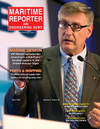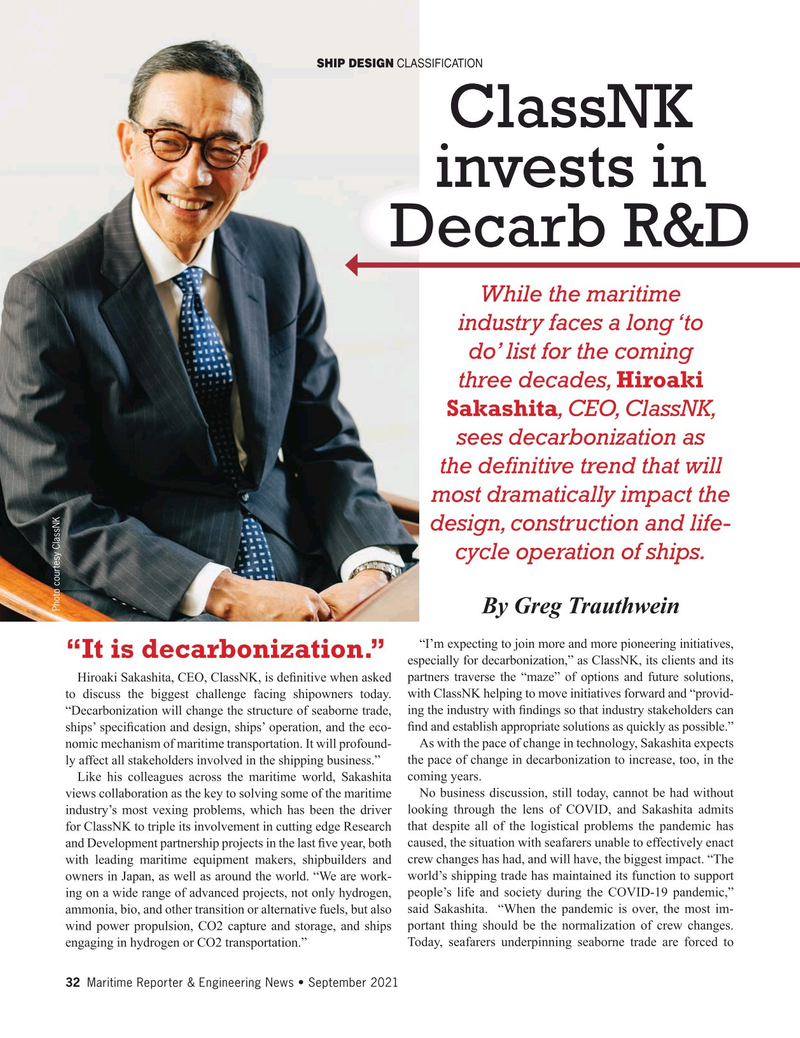
Page 32: of Maritime Reporter Magazine (September 2021)
The Marine Design Edition
Read this page in Pdf, Flash or Html5 edition of September 2021 Maritime Reporter Magazine
SHIP DESIGN CLASSIFICATION
ClassNK invests in
Decarb R&D
While the maritime industry faces a long ‘to do’ list for the coming three decades, Hiroaki
Sakashita, CEO, ClassNK, sees decarbonization as the definitive trend that will most dramatically impact the design, construction and life- cycle operation of ships.
Photo courtesy ClassNK
By Greg Trauthwein “I’m expecting to join more and more pioneering initiatives, “It is decarbonization.” especially for decarbonization,” as ClassNK, its clients and its
Hiroaki Sakashita, CEO, ClassNK, is de? nitive when asked partners traverse the “maze” of options and future solutions, to discuss the biggest challenge facing shipowners today. with ClassNK helping to move initiatives forward and “provid- “Decarbonization will change the structure of seaborne trade, ing the industry with ? ndings so that industry stakeholders can ships’ speci? cation and design, ships’ operation, and the eco- ? nd and establish appropriate solutions as quickly as possible.” nomic mechanism of maritime transportation. It will profound- As with the pace of change in technology, Sakashita expects ly affect all stakeholders involved in the shipping business.” the pace of change in decarbonization to increase, too, in the
Like his colleagues across the maritime world, Sakashita coming years.
views collaboration as the key to solving some of the maritime No business discussion, still today, cannot be had without industry’s most vexing problems, which has been the driver looking through the lens of COVID, and Sakashita admits for ClassNK to triple its involvement in cutting edge Research that despite all of the logistical problems the pandemic has and Development partnership projects in the last ? ve year, both caused, the situation with seafarers unable to effectively enact with leading maritime equipment makers, shipbuilders and crew changes has had, and will have, the biggest impact. “The owners in Japan, as well as around the world. “We are work- world’s shipping trade has maintained its function to support ing on a wide range of advanced projects, not only hydrogen, people’s life and society during the COVID-19 pandemic,” ammonia, bio, and other transition or alternative fuels, but also said Sakashita. “When the pandemic is over, the most im- wind power propulsion, CO2 capture and storage, and ships portant thing should be the normalization of crew changes. engaging in hydrogen or CO2 transportation.” Today, seafarers underpinning seaborne trade are forced to 32 Maritime Reporter & Engineering News • September 2021
MR #9 (18-33).indd 32 9/7/2021 9:52:03 AM

 31
31

 33
33
